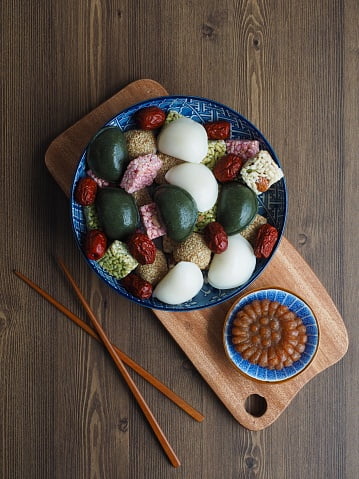
To this day the first day of Korean Lunar New Year (Seol) has always been the most important family holiday, but at the end of the Choseon period (the late 1800s) it was largely spent practicing superstitious rituals to chase away evil spirits in the upcoming year.
For several days prior to the New Year the skies were filled with colorful paper kites, their strings treated with pieces of broken glass controlled by boys and young men as they battled with one another. The idea was to cut the line of your opponent sending their kite hurling to ultimate destruction. The smaller children would often battle one another with small wooden tops, as can still be seen to this day on Korean Lunar new year.
In addition to the kites flying in the air during Korean Lunar new year, there are also stones that often whistled overhead. Each village would select a group of boys and young men who would arm themselves with stones that they had spent hours polishing, straw armor, leather caps, slings and wooden clubs.
These battles generally took place just outside the city walls or in vacant lots near the gates. Spectators lined the walls and hills and watched the battle while making wagers, much like we do with our modern sporting events. It was not uncommon for serious injuries and deaths to occur; in fact, it was almost expected, casualties were treated as mere accident victims.

Not only was the air filled with the sounds of “battle,” but also smoke and the rank smell of burning hair. Many Koreans kept the clippings and locks of hair from their combs and brushes and burned them in small iron pots on Korean Lunar new year. They believed that doing this would prevent one of the many demons from causing mischief within their household. Other people drew images on pieces of paper and then wrote whatever calamity had befallen them. These papers were then given to small boys who burned them.
Some of the roofs had bright red and white round pieces of paper that had been stuck to the end of the sticks. The mudangs [shamans] advised the occupants of the houses that these pieces of paper represented the troubles and illnesses that their homes would suffer in the coming year, but by placing them outside and praying to the lunar god, the troubles could be removed.
Walking the streets with small children was dangerous due to temptation. People made small dolls out of straw and affixed small coins to them and then tossed them into the street to be trampled upon by the animals and passers-by. They believed that the doll contained the troubles and bad luck of the household and if someone should pick up the doll, then the troubles would follow them back to their own homes.

Small children, out of their innocent curiosity, were more likely to pick up the dolls, especially when they noticed the money on them, and would bring them home. Imagine the evil that befell the poor child when their mother realized what they had brought into their home. Perhaps this is why many Koreans to this day believe that found money should be spent before going home.
And that was just the beginning of the superstitions. As the evening wore on people gathered near the bridges of the city as they believed that if you crossed the bridge once for every year of your age, then you would have no pains in your feet and legs during the coming Korean Lunar new year.
Small stands that sold various nuts were set up near these bridges. People would crack the nuts and chew them as prevention for boils and sores – a belief that still persists to this day. Even the dogs were involved. They were not fed that day in the belief that the flies would not pester them so much in the summertime.
If you enjoyed this article about Korean Lunar New Year Superstitions make sure to check out, Explaining Chuseok – Korean Thanksgiving Day.




